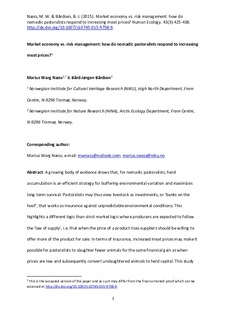| dc.contributor.author | Næss, Marius Warg | |
| dc.contributor.author | Bårdsen, Bård-Jørgen | |
| dc.date.accessioned | 2018-06-18T13:00:34Z | |
| dc.date.available | 2018-06-18T13:00:34Z | |
| dc.date.created | 2015-08-03T09:32:18Z | |
| dc.date.issued | 2015 | |
| dc.identifier.citation | Human Ecology. 2015, 4 (3), 425-438. | nb_NO |
| dc.identifier.issn | 0300-7839 | |
| dc.identifier.uri | http://hdl.handle.net/11250/2501923 | |
| dc.description | This is an Accepted Manuscript of an article published by Springer US in Human Ecology on 05 July 2015, available online: https://link.springer.com/article/10.1007%2Fs10745-015-9758-9 | |
| dc.description.abstract | A growing body of evidence shows that for nomadic pastoralists herd accumulation is an efficient strategy for buffering environmental variation and maximizes long-term survival. Pastoralists may thus view livestock as investments, or ‘banks on the hoof,’ that work as insurance against unpredictable environmental conditions. This perspective differs from strict market logic where producers are expected to follow the ‘law of supply,’ i.e., that when the price of a product rises suppliers should be willing to offer more of the product for sale. In terms of insurance, increased meat prices may make it possible for pastoralists to slaughter fewer animals for the same financial gain as when prices are low and subsequently convert unslaughtered animals to herd capital. This study investigates to what degree Saami reindeer herders follow a market driven or risk management logic by investigating how slaughter strategies are influenced by increasing meat prices. While slaughter strategies vary regionally in Norway, our results indicate that reindeer herders follow neither risk nor market considerations alone, but rather a combination, and support the general hypothesis that slaughter strategies entail balancing the benefits of increasing herd size against economic gain through meat sales. This has important management implications since current management schemes aiming to reduce the number of reindeer by stimulating slaughter rates through economic subsidies is based on the assumption that herders are meat producers motivated by monetary gains alone. | nb_NO |
| dc.language.iso | eng | nb_NO |
| dc.publisher | Springer US | nb_NO |
| dc.rights | Attribution-NonCommercial-NoDerivatives 4.0 Internasjonal | * |
| dc.rights.uri | http://creativecommons.org/licenses/by-nc-nd/4.0/deed.no | * |
| dc.subject | Risk management | nb_NO |
| dc.subject | reindeer husbandry | nb_NO |
| dc.subject | nomadic pastoralism | nb_NO |
| dc.subject | Norway | nb_NO |
| dc.title | Market Economy vs. Risk Management: How Do Nomadic Pastoralists Respond to Increasing Meat Prices? | nb_NO |
| dc.type | Journal article | nb_NO |
| dc.type | Peer reviewed | nb_NO |
| dc.description.version | acceptedVersion | nb_NO |
| dc.rights.holder | © Springer Science+Business Media New York 2015 | |
| dc.subject.nsi | VDP::Sosialantropologi: 250 | nb_NO |
| dc.subject.nsi | VDP::Social anthropology: 250 | nb_NO |
| dc.source.pagenumber | 425-438 | nb_NO |
| dc.source.volume | 43 | nb_NO |
| dc.source.journal | Human Ecology | nb_NO |
| dc.source.issue | 3 | nb_NO |
| dc.identifier.doi | 10.1007/s10745-015-9758-9 | |
| dc.identifier.cristin | 1256012 | |
| dc.relation.project | Norges forskningsråd: 204174 | nb_NO |
| dc.relation.project | Norges forskningsråd: 240280 | nb_NO |
| cristin.unitcode | 7530,45,0,0 | |
| cristin.unitname | Nordområdeavdelingen | |
| cristin.ispublished | true | |
| cristin.fulltext | postprint | |
| cristin.qualitycode | 2 | |

